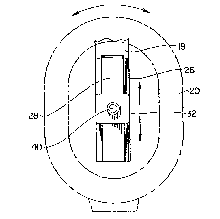Some of the information on this Web page has been provided by external sources. The Government of Canada is not responsible for the accuracy, reliability or currency of the information supplied by external sources. Users wishing to rely upon this information should consult directly with the source of the information. Content provided by external sources is not subject to official languages, privacy and accessibility requirements.
Any discrepancies in the text and image of the Claims and Abstract are due to differing posting times. Text of the Claims and Abstract are posted:
| (12) Patent: | (11) CA 1300033 |
|---|---|
| (21) Application Number: | 1300033 |
| (54) English Title: | SOUND REDUCTION HEADSET |
| (54) French Title: | CASQUE A REDUCTEUR DE VOLUME SONORE |
| Status: | Expired and beyond the Period of Reversal |
| (51) International Patent Classification (IPC): |
|
|---|---|
| (72) Inventors : |
|
| (73) Owners : |
|
| (71) Applicants : |
|
| (74) Agent: | MACRAE & CO. |
| (74) Associate agent: | |
| (45) Issued: | 1992-05-05 |
| (22) Filed Date: | 1988-04-29 |
| Availability of licence: | N/A |
| Dedicated to the Public: | N/A |
| (25) Language of filing: | English |
| Patent Cooperation Treaty (PCT): | No |
|---|
| (30) Application Priority Data: | None |
|---|
Abstract of the Disclosure
An adjustable connector for connecting cups
of a sound reduction headset to a headband. The
connector includes an elastomeric slide that
frictionally is held to the inner of two parallel end
panels forming the terminal end portions of the
headband. The outer panel shields the inner panel from
the wearer's hair and thus serves to prevent the hair
from catching in the slide's operation.
Note: Claims are shown in the official language in which they were submitted.
Note: Descriptions are shown in the official language in which they were submitted.

2024-08-01:As part of the Next Generation Patents (NGP) transition, the Canadian Patents Database (CPD) now contains a more detailed Event History, which replicates the Event Log of our new back-office solution.
Please note that "Inactive:" events refers to events no longer in use in our new back-office solution.
For a clearer understanding of the status of the application/patent presented on this page, the site Disclaimer , as well as the definitions for Patent , Event History , Maintenance Fee and Payment History should be consulted.
| Description | Date |
|---|---|
| Time Limit for Reversal Expired | 2003-05-05 |
| Letter Sent | 2002-05-06 |
| Inactive: Adhoc Request Documented | 1998-05-05 |
| Letter Sent | 1997-05-05 |
| Grant by Issuance | 1992-05-05 |
There is no abandonment history.
| Fee Type | Anniversary Year | Due Date | Paid Date |
|---|---|---|---|
| MF (category 1, 6th anniv.) - small | 1998-05-05 | 1998-03-31 | |
| MF (category 1, 7th anniv.) - small | 1999-05-05 | 1999-04-27 | |
| MF (category 1, 8th anniv.) - small | 2000-05-05 | 2000-02-15 | |
| Reversal of deemed expiry | 2001-05-07 | 2000-02-15 | |
| MF (category 1, 9th anniv.) - small | 2001-05-07 | 2001-03-28 | |
| Reversal of deemed expiry | 2001-05-07 | 2001-03-28 |
Note: Records showing the ownership history in alphabetical order.
| Current Owners on Record |
|---|
| TASCO CORPORATION |
| Past Owners on Record |
|---|
| THOMAS A. SCANLON |